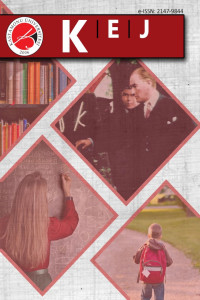Öz
Purpose: This study aims to reveal the abstraction processes developed in the minds of pre-service mathematics teachers in problems in which the The Limit is designed contextually. The abstractions developed by the pre-service teachers in this process will contribute to teaching the concept of The Limit. In this respect, it was aimed to reveal which epistemic actions of the RBC+C abstraction model exhibited in the process of abstracting the concept of The Limit while solving the contextually arranged The Limit problems.
Design/Methodology/Approach: The case study was used in this study. The research participants are 52 (30 female and 22 male) primary school mathematics teacher candidates. Interviews were conducted with three participants selected by the purposive sampling method. In these interviews, five questions were asked by the researchers to reveal the mathematical thinking levels and abstraction processes of the participants. Semi-structured interviews and observation methods were used to collect data. The data were videotaped and transcribed. Transcripts were analyzed and interpreted according to the cognitive actions of the RBC+C model.
Findings: It was determined that the pre-service teachers who were interviewed developed an understanding of The Limits and did not experience any difficulties in using this concept in mathematical operations. However, they needed help in transferring the The Limit information presented in context to new situations, explaining and proving them mathematically. In addition, it was determined that they had difficulty adapting the formal definition to the new situation when faced with the contextual situation in which they could make the formal definition of the The Limit. However, it has been observed that a specific conceptual schema is formed in their minds. This shows that they cannot entirely create The Limit information in their minds. Pre-service teachers structure the formal definition by rote. It was observed that the participants in the excellent category performed the epistemic action of Construction compared to the others.
Highlights: Contextually designed The Limit problems show that pre-service teachers have memorized the formal definition of The Limit in their minds. They needed help transferring the concept of The Limit to different situations and finding solutions to The Limit problems in contextual situations using the formal definition of the The Limit concept. The RBC+C abstraction model is an effective tool in the analysis of contextually designed problem-solving processes.
Anahtar Kelimeler
Abstraction Construction Contextual learning Limit concept RBC+C model
Öz
Purpose: This study aims to reveal the abstraction processes developed in the minds of pre-service mathematics teachers in problems in which the Limit is designed contextually. The abstractions developed by the pre-service teachers in this process will contribute to teaching the concept of Limit. In this respect, it was aimed to reveal which epistemic actions of the RBC+C abstraction model exhibited in the process of abstracting the concept of Limit while solving the contextually arranged Limit problems.
Design/Methodology/Approach: The case study was used in this study. The research participants are 52 (30 female and 22 male) primary school mathematics teacher candidates. Interviews were conducted with three participants selected by the purposive sampling method. In these interviews, five questions were asked by the researchers to reveal the mathematical thinking levels and abstraction processes of the participants. Semi-structured interviews and observation methods were used to collect data. The data were videotaped and transcribed. Transcripts were analyzed and interpreted according to the cognitive actions of the RBC+C model.
Findings: It was determined that the pre-service teachers who were interviewed developed an understanding of limits and did not experience any difficulties in using this concept in mathematical operations. However, they needed help in transferring the limit information presented in context to new situations, explaining and proving them mathematically. In addition, it was determined that they had difficulty adapting the formal definition to the new situation when faced with the contextual situation in which they could make the formal definition of the Limit. However, it has been observed that a specific conceptual schema is formed in their minds. This shows that they cannot entirely create limit information in their minds. Pre-service teachers structure the formal definition by rote. It was observed that the participants in the excellent category performed the epistemic action of Construction compared to the others.
Highlights: Contextually designed Limit problems show that pre-service teachers have memorized the formal definition of Limit in their minds. They needed help transferring the concept of Limit to different situations and finding solutions to limit problems in contextual situations using the formal definition of the Limit concept. The RBC+C abstraction model is an effective tool in the analysis of contextually designed problem-solving processes.
Anahtar Kelimeler
Abstraction Construction Contextual learning Limit concept RBC+C model
Ayrıntılar
| Birincil Dil | İngilizce |
|---|---|
| Konular | Eğitim Üzerine Çalışmalar |
| Bölüm | Research Article |
| Yazarlar | |
| Yayımlanma Tarihi | 31 Ocak 2023 |
| Kabul Tarihi | 7 Aralık 2022 |
| Yayımlandığı Sayı | Yıl 2023 Cilt: 31 Sayı: 1 |


